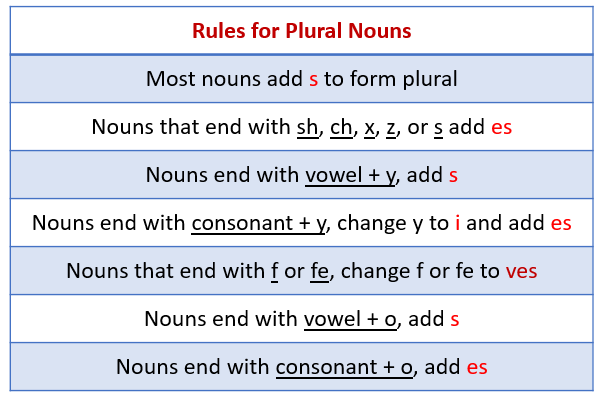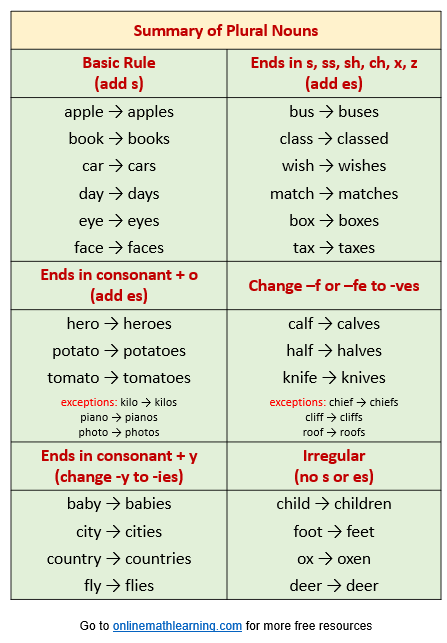Singular Nouns And Plural Nouns
Related Pages
Countable And Uncountable Nouns
Collective Nouns
Gender Nouns
More Lessons On English Grammar
English for Kids
In these lessons, we will learn singular countable nouns and the different spellings for plural nouns.
The following table gives some rules for forming plural nouns. There are some exceptions. Scroll down the page for examples and explanations.

The following diagram shows some rules and examples of plural nouns. Scroll down the page for more examples.

| Plural Nouns | ||
|---|---|---|
| Plural Nouns, add -s | Plural Nouns, add -es | Words ending with y |
| Words ending with f or fe | Words ending with o | Irregular Plural Nouns |
| Summary of Plural Nouns | ||
Singular Countable Nouns
When we are talking about just one person, animal, place or thing, we use a singular countable noun.
Here are some countable nouns that are in the singular.
| cook | comb | bird | map |
| stadium | graph | train | ladder |
Plural Nouns
When we are talking about two or more people, animals, places or things, we have to make the countable nouns plural.
Plural nouns usually end in s.
| Singular | Plural |
| lamp | lamps |
| worker | workers |
| hawk | hawks |
| place | places |
| rope | ropes |
When the last letters of singular nouns are ch, sh, s or x, you usually add es to form the plural. Some exceptions are stomach and monarch where you add s instead of es. This is because the ch in these words sounds like k.
| Singular | Plural |
| arch | arches |
| branch | branches |
| brush | brushes |
| flash | flashes |
| bus | buses |
| address | addresses |
| box | boxes |
| fox | foxes |
| stomach | stomachs |
| monarch | monarchs |
In the case of nouns that end in o, some nouns we need to add s to form the plural whereas others we need to add es to form the plural.
| Singular | Plural |
| kangaroo | kangaroos |
| video | videos |
| zoo | zoos |
| tomato | tomatoes |
| tornado | tornadoes |
| hero | heroes |
| potato | potatoes |
With some nouns that end in y, we form the plural by changing the y to i, and adding es.
| Singular | Plural |
| lady | ladies |
| baby | babies |
| lily | lilies |
| trophy | trophies |
| jelly | jellies |
| story | stories |
However, if there is a vowel before the y (ay, ey, oy, we just add s to form the plural.
| Singular | Plural |
| bay | bays |
| way | ways |
| key | keys |
| jersey | jerseys |
| toy | toys |
| boy | boys |
With some nouns ending in f, the plural ending is ves. We change f to v, and add es.
| Singular | Plural |
| leaf | leaves |
| wolf | wolves |
| calf | calves |
| loaf | loaves |
| thief | thieves |
With some nouns that end in f or fe, we just add s to form the plural.
| Singular | Plural |
| chief | chiefs |
| cliff | cliffs |
| roof | roofs |
| giraffe | giraffes |
With some nouns ending in fe, we change f to v, and add s.
| Singular | Plural |
| knife | knives |
| wife | wives |
| life | lives |
The plural of some nouns is the same as the singular.
| Singular | Plural |
| deer | deer |
| fish | fish |
| salmon | salmon |
| reindeer | reindeer |
| sheep | sheep |
Some nouns are always plural.
| pajamas | jeans | binoculars | goggles |
| spectacles | scissors | trousers | shorts |
| pliers | braces |
The plural form of some nouns is different from the singular form.
| Singular | Plural |
| goose | geese |
| foot | feet |
| ox | oxen |
| child | children |
| woman | women |
| man | men |
| mouse | mice |
Videos
Learn English - Singular Nouns and Plural Nouns
This tutorial describes the difference between singular and plural nouns, as well as other number class related issues.
Forming Plural Nouns with s
This video explains the difference between singular nouns and plural nouns. It shows that when we have 2 or more we use the plural form. It also explains that the plural form is made by adding -s to the noun base.
Forming Plural Nouns with es
When a singular noun ends in the letter s, ss, x, ch, or sh, it will usually become a plural by adding an -es.
Forming Plural Nouns
When the singular noun ends with a y, the plural noun is formed by removing the y and adding an -ies
Plural Irregular Noun
This video shows how some popular irregular nouns change in the plural form. These nouns do not add the “s” at the end of the word.
For eg. man becomes men, woman becomes women, child becomes children, person becomes people, foot becomes feet, tooth becomes teeth, mouse becomes mice, goose becomes geese. Some nouns do not change when they become the plural form, for example, fish and deer.
Some examples of Collective Nouns
A school of fish, a swarm of bees, an audience of listeners, a bouquet of flowers, a bunch of bananas, a forest of trees, a galaxy of stars, a pride of lions, a litter of kittens, a crew of sailors, a range of mountains.
Try out our new and fun Fraction Concoction Game.
Add and subtract fractions to make exciting fraction concoctions following a recipe. There are four levels of difficulty: Easy, medium, hard and insane. Practice the basics of fraction addition and subtraction or challenge yourself with the insane level.

We welcome your feedback, comments and questions about this site or page. Please submit your feedback or enquiries via our Feedback page.